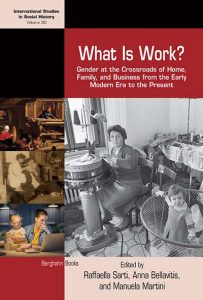Raffaella Sarti, Anna Bellavitis, and Manuela Martini, What is work? Gender at the Crossroads of Home, Family, and Business from the Early Modern Era to the Present, Berghahn Book, New York, 2018
 Every society throughout history has defined what counts as work and what doesn’t. And more often than not, those lines of demarcation are inextricable from considerations of gender. What Is Work? offers a multi-disciplinary approach to understanding labor within the highly gendered realm of household economies. Drawing from scholarship on gender history, economic sociology, family history, civil law, and feminist economics, these essays explore the changing and often contested boundaries between what was and is considered work in different Euro-American contexts over several centuries, with an eye to the ambiguities and biases that have shaped mainstream conceptions of work across all social sectors. Every society throughout history has defined what counts as work and what doesn’t. And more often than not, those lines of demarcation are inextricable from considerations of gender. What Is Work? offers a multi-disciplinary approach to understanding labor within the highly gendered realm of household economies. Drawing from scholarship on gender history, economic sociology, family history, civil law, and feminist economics, these essays explore the changing and often contested boundaries between what was and is considered work in different Euro-American contexts over several centuries, with an eye to the ambiguities and biases that have shaped mainstream conceptions of work across all social sectors.
More informations are available at the editor’s website. |
CONTENTS
List of Figures and Tables
Introduction: What is Work? Gendered Perspectives between Home, Family and Business from the Early Mordern Era to the Present
Raffaella Sarti, Anna Bellavitis, and Manuela Martini
PART I: SETTING THE SCENE: THE FEMINIST CHALLENGES TO THE “DELABORIZATION” OF HOUSEHOLD WORK
- Chapter 1. Family Work: A Policy-Relevant Intellectual History
Nancy Folbre - Chapter 2. Productive and Reproductive Work: Uses and Abuses of an Old Dichotomy
Alessandra Pescarolo - Chapter 3. The Home as a Factory: Rethinking the Debate on Housewives’ Wages in Italy, 1929-1980
Alessandra Gissi
PART II: THE CUNNING HISTORIAN: UNVEILING AND OVERCOMING THE GENDER BIAS OF SOURCES
- Chapter 4. The Statistical Construction of Women’s Work and the Male Breadwinner Economy in Spain (1856-1930)
Cristina Borderías - Chapter 5. Toiling Women, Non-Working Housewives and Rightful Citizens: Statistical and Legal Constructions of Female Work and Citizenship in Italy
Raffaella Sarti - Chapter 6. The Complexities of Work: Analyzing Men’s and Women’s Work in the Early Modern World with the Verb-Oriented Method
Maria Ågren - Chapter 7. The Visibility of Women’s Work: Logics and Contexts of Documents’ Production
Margareth Lanzinger
PART III: THE VALUE OF CARE AND UNPAID HOME-BASED WORK: THE ROLE OF THE LAW
- Chapter 8. Regulating Home Labours: The ILO and the Feminization of Work
Eileen Boris - Chapter 9. Family-Relations Law between “Stratification” and “Resistance”. Housework and Family Law Exceptionalism
Maria Rosaria Marella - Chapter 10. Could Family (Care) Work Be Paid? From French Agricultural Inheritance Law (1939) to Legal Recognition of Excessive Filial Duty (1994)
Florence Weber
PART IV: CONCLUSION
- Conclusion: Can We Construct a Holistic Approach to Women’s Labor History over the Longue Durée?
Laura Lee Downs
Index




